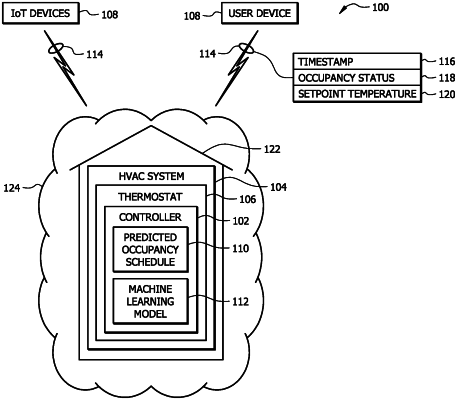| CPC F24F 11/46 (2018.01) [F24F 11/64 (2018.01); F24F 11/65 (2018.01); G05B 13/0265 (2013.01); G05B 13/048 (2013.01); F24F 2110/10 (2018.01); F24F 2120/10 (2018.01); F24F 2120/12 (2018.01); F24F 2140/50 (2018.01); F24F 2140/60 (2018.01)] | 8 Claims |

|
1. A heating, ventilation, and air conditioning (HVAC) control device, comprising:
a memory operable to store a predicted occupancy schedule for a space comprising a plurality of time entries, wherein:
each time entry is associated with a day of the week and an hour of a day;
each time entry is associated with a predicted occupancy status; and
each predicted occupancy status is associated with a confidence level; and
a processor operably coupled to the memory, and configured to:
receive a user input for controlling an HVAC system, wherein the user input comprises instructions for an occupancy setting;
determine whether the user input indicates an energy saving occupancy setting;
identify a first plurality of time entries that are associated with a confidence level for a predicted occupancy status that is less than a predetermined threshold value in the predicted occupancy schedule;
modify the predicted occupancy schedule by setting the first plurality of time entries to an away status in response to determining that the user input indicates a first setting type;
modify the predicted occupancy schedule by setting the first plurality of time entries to a present status in response to determining that the user input indicates a second setting type; and
output the modified predicted occupancy schedule;
wherein:
each time entry in the predicted occupancy schedule is associated with a predicted cooling set point temperature;
each predicted cooling set point temperature is associated with a second confidence level;
the user input comprises instructions for an aggressive cooling set point temperature setting; and
the processor is further configured to:
obtain historical set point temperature information for the space within a predetermined time period, wherein the historical set point temperature information comprises a range of set point temperatures for the space during the predetermined time period;
determine a highest set point temperature for the space during the predetermined time period;
identify a second plurality of time entries that are associated with a second confidence level for a predicted cooling set point temperature that is less than a second predetermined threshold value in the predicted occupancy table; and
modify the predicted occupancy schedule by setting the second plurality of time entries with a predicted cooling set point temperature corresponding with the highest set point temperature.
|